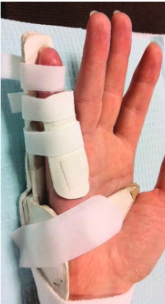|
BOOK NOW |
ASK ABOUT YOUR PAIN |
Home > Blog > Hand Therapy & Customized Splinting > Finger, Hand, Wrist, Forearm & Elbow Conditions > Dupuytren Disease Hand Therapy
Dupuytren Disease Hand Therapy
“Working with a knowledgeable hand therapist can make the difference between success and failure in complex hand surgical cases. The therapist extends the continuum of our care, as well as functioning as coach and trainer for our patients.”
Marybeth Ezaki, MD, Past President, American Society for Surgery of the Hand
In Phoenix Rehab, our senior hand therapists are experienced licensed and dedicated therapists (physiotherapists and/or occupational therapists) who specialized ONLY in the rehabilitation, treatment and management of painful fingers, hands, wrists, forearm & elbow conditions, because of interest, passion and expertise.

Dupuytren disease, also known as Dupuytren contracture, is a condition in the hand that causes the fascia, or layer of tissue beneath the skin, to tighten and draw the fingers into the palm.
Dupuytren disease develops over time and is most common in the ring and small fingers; however, it may be found in any digit of the hand.
What are the symptoms of Dupuytren disease?
Initially patients may feel a lump or thickening of tissue in the palm; however, with time, Dupuytren disease can progress and worsen.
Thick cords may develop in the palm and make it
- difficult to open the hand to hold change
- difficult to place the hand in a pocket
- any movement that involves or requires opening of the hand/palm
The cords may also become sensitive and limit the ability to grip tools.
The tightness of skin in the palm and the bent position of the fingers may take months or years to develop. Dupuytren disease can occur in both hands, although one hand is typically worse than the other.

What causes Dupuytren disease?
Unfortunately, the exact cause of Dupuytren disease is not known.
Dupuytren disease is found most often in older males. Risk factors are
- smoking
- diabetes and
- having a family member with Dupuytren disease
What is the treatment for Dupuytren disease?
Dupuytren disease is typically diagnosed by a physical exam.
Your physician may monitor the nodules for change in size or thickness. For many, the nodules in the palm do not progress or become painful; however, when the fingers become stiff and limit the ability to use the hand, a referral to a hand surgeon is necessary.
Surgery may be performed to remove the nodules and thick tissue in the palm. Your surgeon may also recommend a special injection and manipulation to straighten the fingers.
What can a hand therapist do for me?
Our senior hand therapists works closely with orthopedic doctors to help treat Dupuytren disease after surgery.
Post-operative care involves
- fabrication of an customized splint to keep the fingers extended
- a home exercise program to perform active range of motion and scar management and
- a strengthening program to regain functional use of the hand

Custom-fabricated orthosis for Dupuytren disease
Patients may also receive the following hand therapy treatment modalities:
- cold therapy
- heat therapy
- moist heat paraffin wax therapy
- manual therapy
- joint mobilization
- ultrasound therapy
- etc